What do you do when you want to find a new vet for your pet? You probably start your search online. You look for local vets and read their reviews. You browse through the first page of results and discover veterinary clinics you’ve never heard of, click through their websites, and potentially contact one to make an appointment.
So those veterinary clinics want to get on the first page of search results so they’ll be the one you contact. They do this through a search engine optimization, or SEO, strategy.
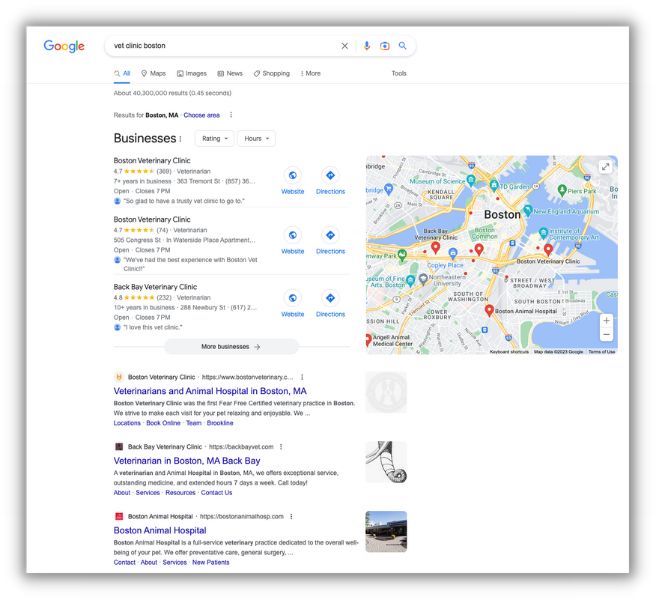
You need good SEO to show up in these spots.
And while the primary focus of SEO is to rank on search engines for queries related to your business, there’s a secondary goal SEO can help you accomplish: lead generation.
By applying some basic best practices of SEO, you can rank higher while getting more customers in the process.
Keep reading to learn more about SEO for lead generation, why it’s important, and how you can use it for your business.
What is SEO for lead generation?
Search engine optimization (SEO) is how you rank on search engine results pages like Google and Bing. SEO often includes improving your website, using keywords, creating content, and updating your website for accessibility. Lead generation is how you identify potential customers and collect information from them for the purpose of converting them into a customer.
SEO for lead generation leverages search engine optimization to create leads for your business. It allows you to show up in search engine results pages (SERP) so you get in front of the audience you want. The more your website shows up on the first page of results, the more people will see your offerings and consider working with your business.

Related: Learn about the differences between lead generation vs. brand awareness here.
Why SEO for lead generation is important to your business
SEO is helpful for creating brand awareness, building a relationship with your audience, and expanding your customer base. Here are a few ways SEO for lead generation can help your business:
Establishes brand recognition
When someone searches for a local business in their area or a keyword you’ve optimized your website for, they will find you! Optimizing your website for lead generation lets customers in need of your services or products learn more about you and drives them to take the next step in the customer journey: becoming a lead.
Creates trust with your audience
People searching online for services and products they need want to find useful information as well as reviews (which can impact your SEO!). When people discover your business through their searches, you have an opportunity to build a relationship with them. If your site provides helpful, actionable information that aids in their journey and you have a solid online reputation, you build trust with your audience.

A strong online presence and good reviews can boost your SEO—and entice prospects to become a lead.
Allows you to compete with competitors
Your competitors are updating their websites, creating content, and posting on social media. If you aren’t developing an SEO strategy, you’re going to be left behind and your potential customers will choose your competitors instead of your business. That’s going to cause you to lose leads–and customers.
How to use SEO for lead generation: 14 tips
To use SEO for any lead generation idea you have in mind, you will first need to audit your website and understand how your business is currently ranking online. Then you’ve got to get to work! Remember that SEO for lead generation is an ongoing journey that will need to be added to your workflow. There will always be more to do.
1. Audit your website
How can you understand what changes you need to make if you don’t review what you’ve already done? Use free tools like SEMrush’s site audit, Ahrefs’ website checker, or LocaliQ’s website grader to access your website’s performance. This will help you determine which web pages need to be updated.
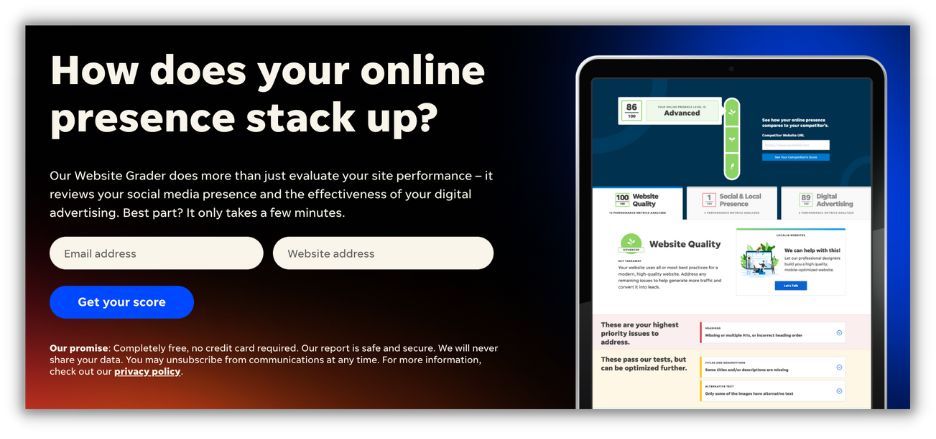
Other items on this list will also give you some ideas to update and improve your website for better SEO for lead generation.
2. Use high-intent keywords on your website
A good SEO strategy includes using keywords related to your business throughout your website pages and blog posts. New customers and clients will find you as they use these keywords to conduct searches on the web, which helps you capture leads.
WordStream’s Free Keyword Tool can help you find the keywords you need. Do local keyword research and include different types of SEO keywords in your website content.
As you conduct keyword research, follow these steps:
- What questions does your audience ask? Use the “people also ask” section on Google to find related search terms. Write answers to these FAQs.
- What topics are related to what you do? For example, if you sell dog bandanas, your audience may also be interested in other dog accessories and have questions about dog health. You could create blog posts that answer these questions.
- What abstract jargon do you need to stay away from? You may know that SaaS stands for software as a service, but your audience may not. Make a list of jargon to avoid.
- What is the intent behind the keywords? Keywords have different types of intent. To generate leads from SEO, you’ll want to target high-intent keywords that are related to a purchase, as well as a healthy mix of other types of keywords.

These questions can help you build an FAQ page that can drive more leads from your SEO efforts.
3. Create and update a blog
There’s a lot of competition when it comes to ranking for searches related to your business. In order to increase your chances of ranking for these searches, you need to invest in creating high-quality content. Creating a blog and regularly posting articles on it is an effective way to attract new leads to your website. Prospective customers will read your content and get to know your business and your area of expertise. Your blog content can also help move them down the sales funnel.
For example, if you’re a plumber, you can target long-tail keywords in blog posts that potential customers might search for. Once they read your content and see that you’re an expert, they’ll be more likely to contact you for their next plumbing emergency.
If you haven’t yet developed a blog, think about doing the following:
- Create a content schedule or editorial calendar so you publish regularly
- Publish high-quality content that is useful to your customers and audience
- Include a call to action (CTA) in each blog post
- Use H2 and H3 subheadings in your content
- Use short-tail keywords and long-tail keywords
- Link to other website pages and blog posts

This dog food company’s blog has content that would attract pet owners, even if they’re not looking for dog food specifically.
The work isn’t done once it’s published! You must make content promotion a priority, and share it across your social media profiles. You will also want to regularly update blog posts so they continue to rank high and compete against related content.
Additionally, you need to think about repurposing content. Can you turn that blog post into a YouTube script? Can you pair a free webinar with the launch of a new blog post? Promoting and repurposing content will improve your search engine ranking and allow you to get more mileage from the same work.
4. Update your website to be accessible
Your website needs to be accessible to everyone who encounters it. Your customers may not be able to see your brand colors, read your content, or understand your services without digital accessibility. An ADA-compliant website will boost your SEO, allow you to serve a larger customer base, and hopefully avoid tricky legal situations down the road.
Work on creating an accessible website:
- Use alternative text for your images
- Use accessible color contrasts
- Transcribe video content
- Create an organized website layout
- Use inclusive language

You can use a tool like WebAIM to check your color contrasts on your website.
5. Improve your website speed
If your website is taking too long to load, your audience is going to have a hard time consuming your content and taking the next step to becoming a lead. Many people will abandon a webpage if it takes more than a few seconds to load. This is why slow page loading rates lead to high bounce rates, which in turn hurts your SEO ranking.
Speed up your website loading time:
- Optimize images for the web
- Delete old content
- Repair or redirect broken links
- Remove spam comments
- Create a mobile-responsive website

You can use a tool like Google’s PageSpeed Insights to check your site speed.
6. Optimize your website for mobile
Google Analytics Data shows that 50% of web traffic comes from mobile. Consider just how many people will read your blog or scroll through your website on their phones.
Is your website optimized for mobile? Without a mobile-friendly site, it’s nearly impossible to drive users to your website from search engines and convert them into a lead.
A mobile-optimized site is good for both SEO and lead generation because it increases visibility and makes it much easier for people to contact your business or leave their contact information on your website.
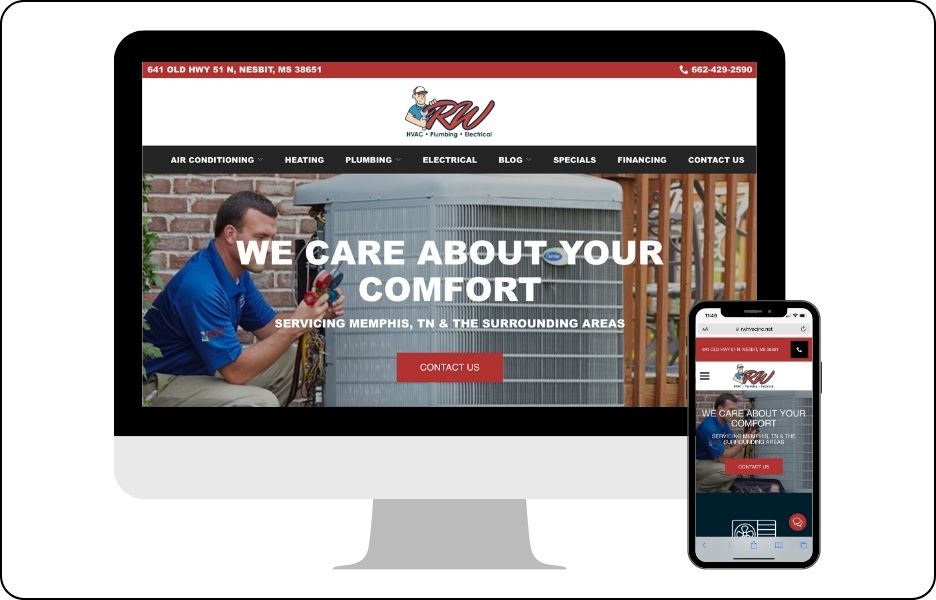
This website looks good on both mobile and desktop.
7. Manage your local listings
When people Google your name, they’ll see any business listings connected to your business—whether you manage them or not. Local listings contain important information about your business, including contact details, your website URL, hours of operation, and reviews.
Managing your directory listings is an important component of SEO because it sends trust signals to Google and other search engines. The more consistent information search engines can find about your business online, the more confidence these search engines have in the information they’re displaying about your business.
This can help with lead generation because it can drive more people to contact you directly through your listings or visit your website from there.
You need to manage listings for your business on Yelp, Google, and Facebook (to name a few!). Google your business name (or use our free business listings grader) and see what listings show up. By managing these listings, you can correct any outdated or incorrect information and respond to reviews from your customers.
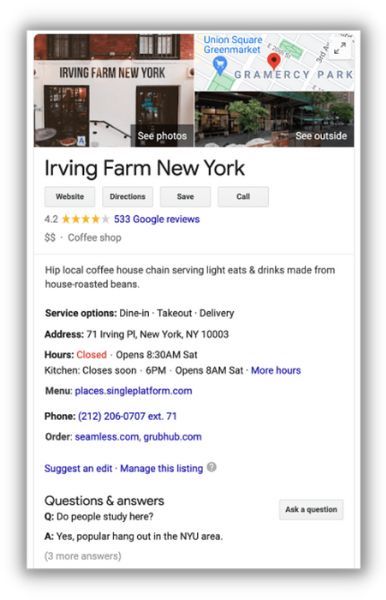
8. Create social media posts
In addition to working on your website and listings, you need to work on your social media strategy. While social media doesn’t directly influence SEO, your social sites can rank in search engines for your business name. Plus, your customers expect to see you online and may look through your social media posts before deciding to work with you.
Create and update your Instagram, Snapchat, TikTok, and other social media accounts. Focus on social media platforms that have the audience you want.
Make sure to always:
- Use relevant hashtags
- Include keywords in your bio and page name
- Create giveaways and contests to generate awareness and activity

9. Leverage link building
There are two ways to leverage link building: by linking to your own content throughout your site and by having other websites link to your content.
You need to link to your website’s content throughout your website to build internal links. Your audience will be able to continue exploring relevant content directly through your links. For example, Purina’s article about American Wirehair cats links to related content published on its website. Readers interested in the breed can also learn about low-shedding breeds, cat food, and about their health.

Ideally, other websites will also link to your content. Search engines use these backlinks to authenticate your content as a credible source. You can try to get links from other sites by creating content worth linking to, or by writing guest posts for their sites.
10. Consider a YouTube SEO strategy
YouTube is one of the top search engines in the entire world. Adding a YouTube SEO strategy to your marketing plan is one way to generate leads and get new customers. People of all ages use YouTube to search for answers to their questions or to entertain themselves and their families. Plus, if they’re not searching directly on YouTube, videos may still show up prominently in search results for relevant searches.
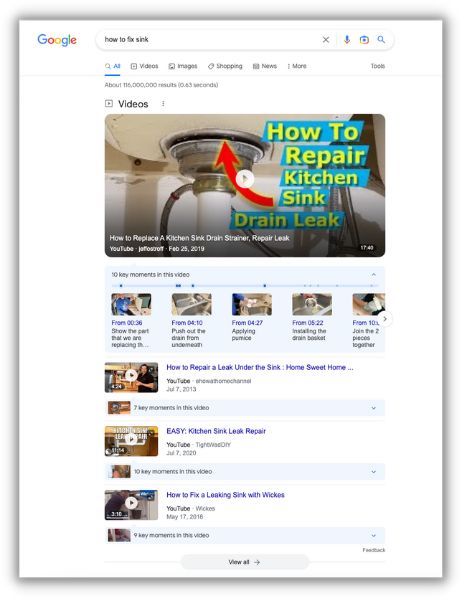
Video content is appealing to people for all kinds of reasons, so you’ll want to be where the people are. Consider creating YouTube Shorts that tell your customers important tips and tricks, or share entertaining how-to videos. Create videos that fit your brand voice, and have fun with it! In fact, 57% of Gen Z agree that they like it when businesses participate in memes.
11. Use and test calls to action
Include a call to action in your blog posts, social media content, YouTube videos, and newsletters. While keywords may get visitors to your website, calls to action tell them what next steps to take—which is where the lead generation piece comes in.
Your call to action will vary depending on your goals. It may look like:
- Learn more about furniture repair
- Let us help you reach your goals
- Let’s work together

This site includes two prominent CTAs.
12. Look at what your competitors are up to
Take a look at what your competitors are doing. Are they active on social media? What are they writing about in their blog? What assets are they lacking?
If you can use your SEO strategy to address these gaps—either through content you’re creating, keywords you’re targeting, or FAQs you’re adding to your website—you can rank better and generate more leads.
Try doing a SWOT analysis to find these key areas that you should focus on and start working on a few key pieces to see if they move the needle.

13. Ask for testimonials
What’s the first thing you check for before buying a product or service? Customer reviews of course! Adding testimonials to your website is an excellent way to prove how useful your business is to people and can help boost SEO if those testimonials include relevant keywords. Ask customers to write a short testimonial that you can use on your website.
If you’re not comfortable asking people for testimonials, you can pull a quote from reviews left on your social media channels or online. Include a link to the source.
Blue Apron compiled a few of its top testimonials and displayed them on its website. They’re a compelling reason to buy a subscription.

14. Avoid SEO mistakes
In addition to doing good work, you need to avoid making crucial mistakes. SEO mistakes can harm your business and hurt your credibility.
- Don’t participate in link buying
- Don’t create duplicate content
- Don’t write in the same color as your website’s background to hide keywords
- Don’t participate in keyword stuffing (using as many keywords as possible)
- Don’t publish images, copy, and content that doesn’t belong to you
Use SEO for lead generation
SEO lead generation will help your business reach its goals. If you don’t leverage SEO to get new customers, you’re missing out. Your competitors will be using SEO lead generation to land new acquisitions and you should too.
Invest your time and resources in using SEO for lead generation with these tips:
- Audit your website
- Use high-intent keywords on your website
- Create and update a blog
- Make your website accessible
- Improve your website speed
- Optimize your website for mobile
- Manage your local listings
- Be active on social media
- Leverage link building
- Add a YouTube SEO strategy to your marketing plan
- Use and test calls to action
- Ask for testimonials
- Look at what your competitors are doing
- Avoid SEO mistakes
This may seem like a long list and a huge commitment, but it will be worth it.





